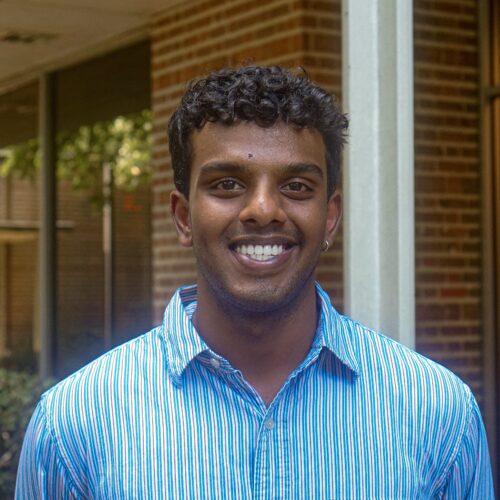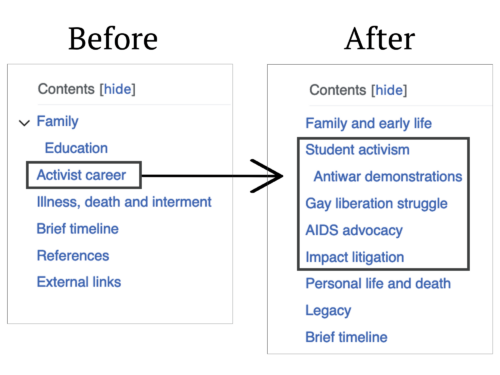
One day in December, Naven Parthasarathy ran into his professor Diana Strassmann, who, to his surprise, congratulated him. “She was like, you didn’t hear?” Naven recounts. It turns out, the Wikipedia biography that he had written about Kiyoshi Kuromiya as part of Dr. Strassmann’s course at Rice University had been read 800K times in the year since the course wrapped up!
“She mentioned that Kiyoshi was featured as a Google Doodle. I think that that’s really cool because that’s something that I grew up on,” says Naven.
It’s true, on June 4, 2022, Google featured Kuromiya on its front page. 640K internet users flocked to Wikipedia that day alone to read about Kuromiya’s legacy as an activist. What they found was a full story of a man’s life that Naven had stitched together from academic sources. Kuromiya’s activism spanned decades of social issues–from the civil rights movement and anti-war protests to gay liberation and HIV/AIDS education.
“One of the coolest things I found in my research was that he knew all these historical figures,” Naven says enthusiastically. “I saw that he knew people in the Black Panther party and he got inspired by Malcolm X!”
But before Naven’s interventions, the biography only gave broad strokes about Kuromiya’s work. It didn’t tell the story of why he fought so passionately and relentlessly. Nor did it go into depth about his accomplishments. The gaps surprised Naven given how interesting he found Kuromiya to be.
“The more I found out about him, the more I wanted to write. But all the different facets of his activism, which he did through his whole life–from college all the way to the Supreme Court– were left out of the page.”

Thankfully, Naven expanded the biography 6 months before Google featured Kuromiya as one of their Doodles. Naven’s edits give readers a better sense of Kuromiya’s personality, relationships, and values. Instead of simply listing a series of events, the biography now paints a picture of a person committed to helping others be treated as full humans and feel less alone. That’s what Naven connected with most while researching.
“Kiyoshi felt the need to get information out to people, especially about HIV and AIDS. He believed these are resources everyone should have, especially incarcerated people–that’s the last person that’s gonna get the resources they need. That was powerful. You could tell he was saying, If the government’s not going to do it, then I’m going to do it. Him just stepping up was the big message that hit home for me. With all the movements he was involved in, I don’t think that Kiyoshi said oh this affects me personally but he saw it as an injustice anyway. That was something I was able to learn from and use outside the classroom.”
Naven found himself getting inspired by Kuromiya’s life as he filled in the gaps on Wikipedia where he could. He could see parallels: he and Kuromiya are both first generation Asian Americans who ventured outside of their hometown community to go to college in another state. And reading about Kiyoshi’s unique approach to organizing got Naven thinking about how he could make a difference at his own campus for issues he cares about.
“Researching Kiyoshi’s life helped lower the barrier for me to get into activism. At first I saw it as some foreign thing, or something that professionals do. I never really thought about just taking that initial step. Around the time of the World Cup, there was a protest at my school supporting activists in Iran. It was small, but we had picket signs and it was really a powerful thing. I felt really good being there and I didn’t feel like a stranger that I have no ties to Iran. I just felt solidarity was something that was important in that moment.”
The assignment also inspired Naven to focus his sociology degree on social movements. “Before doing this class and writing this article, it wasn’t really something that was on my radar,” Naven says. “But now, learning more about different social movements has been really some of the most interesting work I’ve done in the last semester or two.”
Naven appreciated learning how to write in an encyclopedic style, too, citing every sentence with a reliable source and distilling information into the appropriate tone. “That was the first time I’d ever done something like that so it was cool. Won’t be the last.”
Naven hopes readers of the biography are as inspired as he is. He thinks we have a lot to learn from someone as passionate as Kuromiya.
“I think the last couple years have changed the way people thought about protests. But seeing someone who was doing these things in the 60s, 70s, 80s in a really unique way–that in and of itself is a good story to tell. And hopefully people can take something out of that, because I know I did.”
Visit teach.wikiedu.org to learn about incorporating a Wikipedia assignment into your course with Wiki Education’s free templates, tools, and support.
